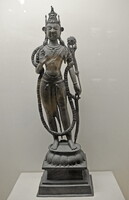| dc.coverage.spatial | Site: Prince of Wales Museum of Western India (Mumbai, Mahārāshtra, India) 67.5 | en_US |
| dc.coverage.temporal | ca. 9th century CE (creation) | en_US |
| dc.creator | unknown (Indian (South Asian)) | en_US |
| dc.date | 800-899 | en_US |
| dc.date.accessioned | 2016-08-23T18:14:00Z | |
| dc.date.available | 2016-08-23T18:14:00Z | |
| dc.date.issued | 800-899 | en_US |
| dc.identifier | 268029 | en_US |
| dc.identifier.other | archrefid: 3389 | en_US |
| dc.identifier.uri | http://hdl.handle.net/1721.3/184343 | |
| dc.description | Overall view, standing on lotus base and holding a lotus flower; Having crystallized by the mid-8th century, the Kashmiri style continued for over 300 years with only minor changes; Buddhism was equally popular in Kashmir as Hinduism. Most Kashmiri bronzes of deities have a nimbus and body aureole; this practice extended even to small bronzes from adjoining areas. The bodhisattva Avalokitesvara holds a lotus as his principal attribute. Avalokiteśvara may be depicted as either male or female, and as the bodhisattva who embodies the compassion of all Buddhas, Avalokiteśvara is one of the more widely revered bodhisattvas in mainstream Mahayana Buddhism, as well as unofficially in Theravada Buddhism. Source: Grove Art Online; http://www.oxfordartonline.com/ (accessed 4/9/2015) | en_US |
| dc.format.medium | bronze | en_US |
| dc.rights | © Scott Gilchrist, Archivision, Inc. | en_US |
| dc.subject | deities | en_US |
| dc.subject | human figure | en_US |
| dc.subject | Buddhism and art | en_US |
| dc.subject | Buddhist | en_US |
| dc.subject | CSMVS | en_US |
| dc.subject | Kashmiri (culture or style) | en_US |
| dc.title | Avalokiteshvara | en_US |
| dc.title.alternative | Bodhisattva Avalokiteshvara | en_US |
| dc.type | image | en_US |
| dc.rights.access | Licensed for educational and research use by the MIT community only | en_US |
| dc.identifier.vendorcode | 7A2-IN-PWM-ACAL-A01 | en_US |
| vra.culturalContext | Indian (South Asian) | en_US |
| vra.technique | casting (process) | en_US |
| vra.worktype | sculpture (visual work) | en_US |
| dc.contributor.display | unknown (Indian) | en_US |

